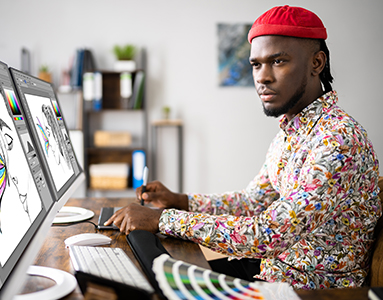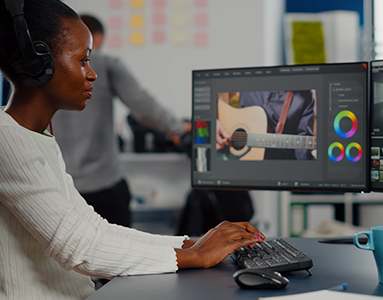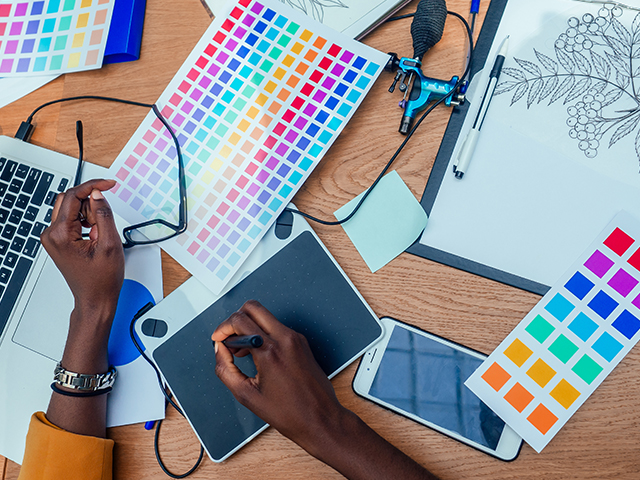Graphic Design, B.S.
About This Program
As a graphic design student, you will delve into the visual language of design, exploring the principles of layout, typography, color theory, and digital tools. The curriculum encompasses hands-on experience with industry-standard design software, allowing you to learn to craft compelling visual narratives for a variety of mediums, including print, digital, video, and multimedia platforms.
By graduation, you will possess a diverse portfolio displaying your proficiency in creating visual identities, marketing materials, and digital interfaces, preparing you to contribute to the visual storytelling of individuals, businesses, organizations, and brands across diverse industries.

What is Graphic Design?
Graphic design is the art and practice of planning and projecting ideas and experiences with visual and textual content. It is the process of creating visual communications and platforms, such as logos, brochures, magazines, websites, motion graphics, mobile apps, and other graphic materials. Graphic designers use typography, images, shapes, textures, elements, and color to communicate ideas in a visually appealing and effective way.
Graphic designers play a key role in our everyday lives. Their work can be seen in everything we view and engage with, from the logos on our clothes, to the websites we visit, to the packaging of the food we eat, and to the street signs that direct us. Graphic design can be used to inform, educate, entertain, and persuade. It can help businesses to connect with their customers and build their brands. It can also be used to promote social causes and raise awareness of important issues. Graphic design is a powerful tool that can be used to communicate a wide range of ideas and messages. It is an essential part of our visual culture and plays a significant role in our everyday lives.
Graphic design is a broad field that encompasses many different disciplines, including:
• Branding: Creating visual identities for businesses and organizations.
• Editorial Design: Designing magazines, newspapers, and other print publications.
• Web Design: Designing and creating websites and digital interfaces.
• Motion Graphics: Creating animated graphics and videos.
• Packaging Design: Designing packaging for products and goods.
• Advertising Design: Creating visual ads for print, TV, film and digital media.
• UX/UI Design: Creating a better user experience for mobile apps and websites.

Graphic Design Careers
There are many career paths for those with graphic design skills and a passion for
the field. They include:
• Advertising Designer: An advertising designer is a graphic designer who specializes in creating visual advertisements for print, TV and digital media. They work with clients to develop a creative brief and visuals that communicate the desired message in a way that is visually appealing and persuasive.
• Art Director: Art directors oversee the visual identity of a company or organization. They work with graphic designers, photographers and other creative professionals to develop and implement a visual style or presence that is consistent and effective across all platforms.
• Animation Designer: An animator designer is a creative professional who creates visual effects and animated characters for a variety of media, including films, television shows, and video games.
• Brand Designer: Brand designers create visual identities for businesses and organizations. This includes
developing logos, color palettes, typography, and visual elements that represent the
brand.
• Creative Director: Creative directors oversee the creative vision of a project or campaign. They work
with art directors, graphic designers, copywriters, and other creative professionals
to develop and implement a creative strategy that achieves the desiredresults.
• Editorial Designer: Editorial designers design magazines, newspapers and other print publications. They
work with editors and writers to create layouts that are both visually appealing and
informative.
• Environmental Graphic Designer: Environmental graphic designers design signage, murals and other visual elements
for public spaces. They work with architects, interior designers, and other professionals
to create visual environments that are both functional and aesthetically pleasing.
• Fashion Designer: A fashion designer is a creative professional who designs clothing, accessories and
footwear. They use their creativity, knowledge of trends and understanding of the
human body to create garments that are both functional and aesthetically pleasing.
Fashion designers typically work for design houses or fashion brands, but they can
also be self-employed.
• Game Designer: Game designers create video games. They work with artists, programmers, and other
creative professionals to develop the visual style, storyline and gameplay of video
games.
• General Graphic Designer: Graphic designers in general create visual content for a variety of mediums, including
print, web and social media. They work with clients to develop a creative brief and
then create visuals that communicate the desired message.
• Education Graphic Designer: A graphic designer in education is a creative professional who designs visual communication
materials for schools, training programs, and colleges and universities. They work
with a variety of stakeholders, including faculty, staff, students, academic leaders,
funders, and alumni, to create marketing, promotional, informational, brand identity,
and special event materials that are both informative and visually appealing.
• Motion Graphics Designer: Motion graphics designers create animated graphics and videos. They work with clients
to develop a creative brief and then create visuals that communicate the desired message
in a visually appealing and engaging way.
• Package Designer: Package designers design packaging for products and goods. Theywork with clients to
develop a creative brief and create packaging that is both functional and visually
appealing.
• UI/UX Designer: UI/UX designers design user interfaces and user experiences for websites and digital
products. They work with users and clients to understand their needs and then design
interfaces that are easy to use and navigate.
• Web Designer: Web designers design and create websites. They work with clients to develop a creative
brief and then create websites that are both visually appealing and functional.

Graphic Design Expectations
According to the U.S. Bureau of Labor, in 2023, the average income for a national graphic designer was:
- An average of $31.11 an hour
-
A mean salary of $64,700
The states with the highest employment level in Graphic Design are:
- California,
- New York,
- Texas,
- Florida
- Illinois

Graphic Design Frequently Asked Questions (F.A.Qs)
Q: Do you have to be a good artist to be a graphic designer?
A: While having a natural artistic inclination can be beneficial for a graphic designer,
it's not a strict requirement. Graphic design involves a combination of artistic creativity
and technical skills. Many successful graphic designers have a diverse set of skills
that go beyond traditional artistry.
Q: What are some of the essential skills graphic designers should develop for success?
A: To achieve success, graphic designers should hone skills such as creativity and problem-solving,
understanding design principles, technical proficiency, presentation, communication,
time management, and collaboration.
Q: What industries have the highest levels of employment in graphic designers?
A: Advertising, public relations, and related services; specialized design services;
printing and related support activities; newspaper, periodical, book, and directory
publishers; management; and scientific and technical consulting services.
Q: What are the top-paying industries for graphic designers?
A: Motion picture and video industries; media streaming distribution services, social
networks, media networks, and content providers.
Program Faculty
| Name | Phone | |
|---|---|---|
| Mr. Anosh Gill, Division Director | (850) 412-7137 | |
| Mr. Carlos Miranda, Assistant professor | (850) 599-3379 | |
| Ms. Alicia Hope, Assistant Instructor | (850) 599-3000 | |
| Mr. Stanley Johnson, Visiting Professor | (850) 599-3379 | |
| Ms. Michele Dames, Adjunct Instructor | N/A | |
| Ms. Eunyoung Park, Adjunct Instructor | (850) 599-3379 | |
| Mr. Anthony Rundles, Adjunct Instructor | (850) 412-5395 | |
| Ms. Ranata Hughes, Internship Coordinator and Adjunct Professor | (850) 412-5395 |





